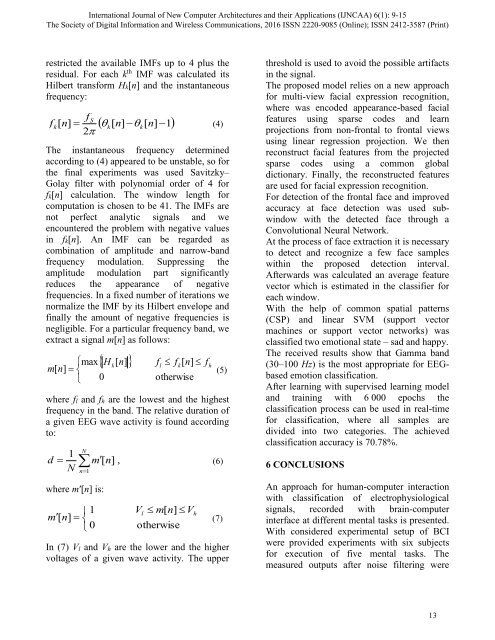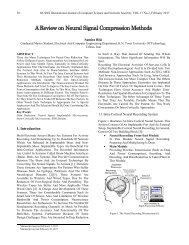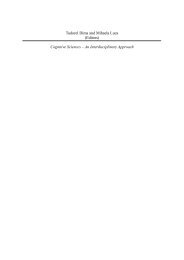New Computer Architectures and their Applications
IJNCAA_Vol6No1
IJNCAA_Vol6No1
Create successful ePaper yourself
Turn your PDF publications into a flip-book with our unique Google optimized e-Paper software.
International Journal of <strong>New</strong> <strong>Computer</strong> <strong>Architectures</strong> <strong>and</strong> <strong>their</strong> <strong>Applications</strong> (IJNCAA) 6(1): 9-15<br />
The Society of Digital Information <strong>and</strong> Wireless Communications, 2016 ISSN 2220-9085 (Online); ISSN 2412-3587 (Print)<br />
restricted the available IMFs up to 4 plus the<br />
residual. For each k th IMF was calculated its<br />
Hilbert transform Hk[n] <strong>and</strong> the instantaneous<br />
frequency:<br />
fS<br />
fk[ n]<br />
<br />
k[<br />
n]<br />
k[<br />
n]<br />
1<br />
2<br />
(4)<br />
The instantaneous frequency determined<br />
according to (4) appeared to be unstable, so for<br />
the final experiments was used Savitzky–<br />
Golay filter with polynomial order of 4 for<br />
fk[n] calculation. The window length for<br />
computation is chosen to be 41. The IMFs are<br />
not perfect analytic signals <strong>and</strong> we<br />
encountered the problem with negative values<br />
in fk[n]. An IMF can be regarded as<br />
combination of amplitude <strong>and</strong> narrow-b<strong>and</strong><br />
frequency modulation. Suppressing the<br />
amplitude modulation part significantly<br />
reduces the appearance of negative<br />
frequencies. In a fixed number of iterations we<br />
normalize the IMF by its Hilbert envelope <strong>and</strong><br />
finally the amount of negative frequencies is<br />
negligible. For a particular frequency b<strong>and</strong>, we<br />
extract a signal m[n] as follows:<br />
<br />
max<br />
H<br />
m[<br />
n]<br />
<br />
0<br />
k<br />
[ n]<br />
<br />
f<br />
l<br />
<br />
f [ n]<br />
f<br />
k<br />
otherwise<br />
h<br />
(5)<br />
where fl <strong>and</strong> fh are the lowest <strong>and</strong> the highest<br />
frequency in the b<strong>and</strong>. The relative duration of<br />
a given EEG wave activity is found according<br />
to:<br />
d<br />
1<br />
<br />
N<br />
N<br />
<br />
n1<br />
where m′[n] is:<br />
m[<br />
n]<br />
,<br />
(6)<br />
1 Vl m[<br />
n]<br />
V m [<br />
n]<br />
<br />
h<br />
<br />
(7)<br />
0 otherwise<br />
In (7) Vl <strong>and</strong> Vh are the lower <strong>and</strong> the higher<br />
voltages of a given wave activity. The upper<br />
threshold is used to avoid the possible artifacts<br />
in the signal.<br />
The proposed model relies on a new approach<br />
for multi-view facial expression recognition,<br />
where was encoded appearance-based facial<br />
features using sparse codes <strong>and</strong> learn<br />
projections from non-frontal to frontal views<br />
using linear regression projection. We then<br />
reconstruct facial features from the projected<br />
sparse codes using a common global<br />
dictionary. Finally, the reconstructed features<br />
are used for facial expression recognition.<br />
For detection of the frontal face <strong>and</strong> improved<br />
accuracy at face detection was used subwindow<br />
with the detected face through a<br />
Convolutional Neural Network.<br />
At the process of face extraction it is necessary<br />
to detect <strong>and</strong> recognize a few face samples<br />
within the proposed detection interval.<br />
Afterwards was calculated an average feature<br />
vector which is estimated in the classifier for<br />
each window.<br />
With the help of common spatial patterns<br />
(CSP) <strong>and</strong> linear SVM (support vector<br />
machines or support vector networks) was<br />
classified two emotional state – sad <strong>and</strong> happy.<br />
The received results show that Gamma b<strong>and</strong><br />
(30–100 Hz) is the most appropriate for EEGbased<br />
emotion classification.<br />
After learning with supervised learning model<br />
<strong>and</strong> training with 6 000 epochs the<br />
classification process can be used in real-time<br />
for classification, where all samples are<br />
divided into two categories. The achieved<br />
classification accuracy is 70.78%.<br />
6 CONCLUSIONS<br />
An approach for human-computer interaction<br />
with classification of electrophysiological<br />
signals, recorded with brain-computer<br />
interface at different mental tasks is presented.<br />
With considered experimental setup of BCI<br />
were provided experiments with six subjects<br />
for execution of five mental tasks. The<br />
measured outputs after noise filtering were<br />
13






